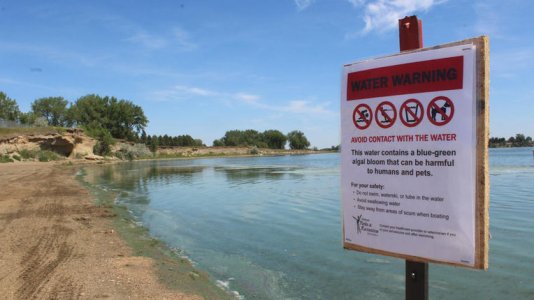
A toxic blue-green algae bloom in Patterson Lake has prompted the North Dakota Department of Health to issue a warning urging people to stay out of the water.
Mike Ell, an environmental scientist in the department's division of water quality, said a series of tests conducted earlier this week discovered hazardous levels of a toxin—specifically, a cyanotoxin known as microcystin—released by the algae that can be lethal if ingested.
Ell said there "isn't any kind of antidote" for cyanotoxins. Symptoms of poisoning can occur as soon as an hour after exposure to affected water and include rashes, inflamed nasal passages and congestion. Ell said ingestion can cause nausea and diarrhea at lower levels. At higher levels, the toxin can be deadly.
"More than likely, it's going to be pretty quick," he said, adding that a dog could succumb to cyanotoxin poisoning within three hours.
Currently, the health department has only measured microcystin, which causes what Ell described as "more of a long-term condition" that damages the liver. The more serious effects of that toxin can take as long as 24 hours to manifest themselves. Ell said a more serious brain-affecting cyanotoxin produced by blue-green algae and known as anatoxin-a has not been found in the lake thus far.
Ell said the health department's threshold for toxin levels dangerous to people is measured at 10 micrograms per liter of water. Tests conducted with samples taken from the lake's public swim beach found microcystin measuring at 19 micrograms per liter. The water by the boat ramp closer to the reservoir's dam measured far higher, with a concentration of 95 micrograms per liter.
While ingestion of the water is harmful for humans and other animals, Ell said there's no evidence that cyanotoxins accumulate in fish. Recreational fishing is still a safe activity, though Ell recommended anglers avoid contact with the water as much as possible and wash their catch before filleting.
Matt Mack, Dickinson Parks and Recreation facility operations manager, said the lake's live-in caretaker had noticed the bright blue algae before the holiday weekend on the beach. Mack contacted the state health department to conduct a first round of tests which discovered cyanotoxins in levels below the hazardous threshold. The parks district put up signs then to advise people to take caution.
However, when Mack returned to the lake on Tuesday, he said it appeared to have gotten even worse.
"Last year, towards the end of the season, it was kind of brought up," he said of the algae. "It never got to this level though. In my experience, and I've been here for eight years, I've never seen it like that. I grew up in Dickinson and I never saw it that bad either."
The dead algae on the beach is likely even more dangerous than the living material in the water. Ell said most of the toxins are released from the algae's cells after the organism dies and begins to decay, a process which often occurs close to shore as winds push algae mats across a body of water.
Kevin Pavlish, Southwest District Health environmental health practitioner, said his office sees blooms of this nature more frequently in stock ponds in years without much moisture. As water levels drop and mineral nutrients, such as nitrates and phosphates, are present in an increasing concentration, algae can find a ready foothold. When boosted by summer sunlight, algae can grow in sudden bursts.
Pavlish said the low water levels in the nutrient-rich Patterson Lake make it "not surprising" that algae is thriving there.
"Pray for a lot of rain, that's the one solution to the whole thing," he said.
